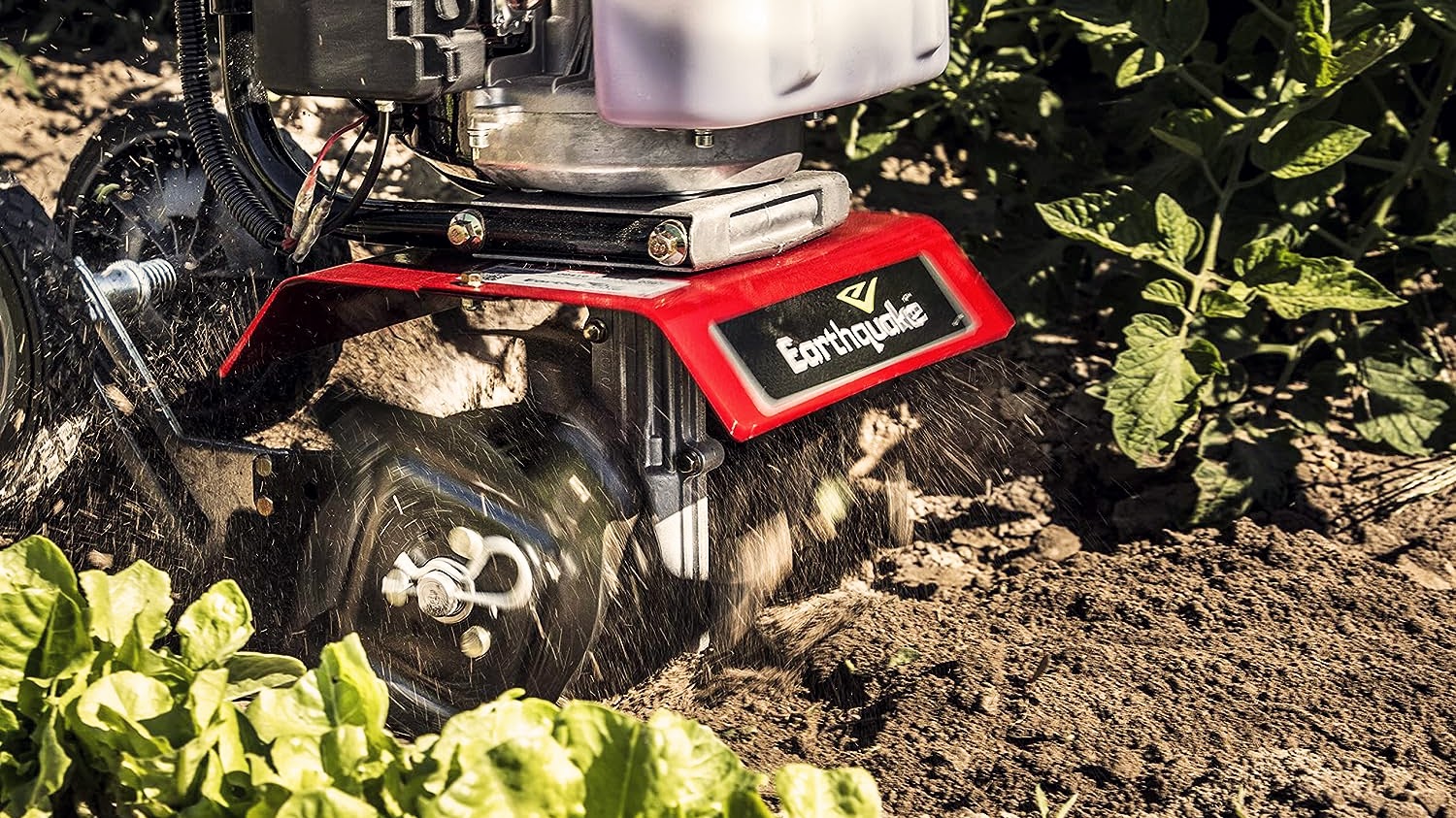Owning one of the best tillers will help you prepare your soil for a season of thriving flowers by breaking up established roots and loosening the soil.
When choosing a tiller, consider your plot's needs. If you have soft soil, a basic tiller should work well and save you money. However, if your soil is tougher and denser, you may need a more powerful option. Most tillers can turn the soil at a depth of six to eight inches, which is suitable for the average garden. The width of the tiller is also important to consider, as wider models allow you to cover more ground quickly.
To help you choose the right tiller, we've put together a guide featuring our top five recommendations. While our review panel has tested various tillers, we haven't been able to personally test and review every model mentioned in this guide. Instead, we focused on top-rated brands and utilized our knowledge of the best tiller specifications to refine our list. This includes factors such as tine depth, path width, engine size, and overall appearance of the yard tool.
If you want to keep your garden looking at its best, you may want to check out our guides to the best string trimmers and lawn mowers, too; for now, let’s dig into our picks of the best tillers.
The quick list
Below, we’ve provided an overview of the important details you need to know about each product immediately so you can buy quickly if you're in a hurry. If something catches your eye, use the links to delve deeper into the analysis provided for each product further down the page.
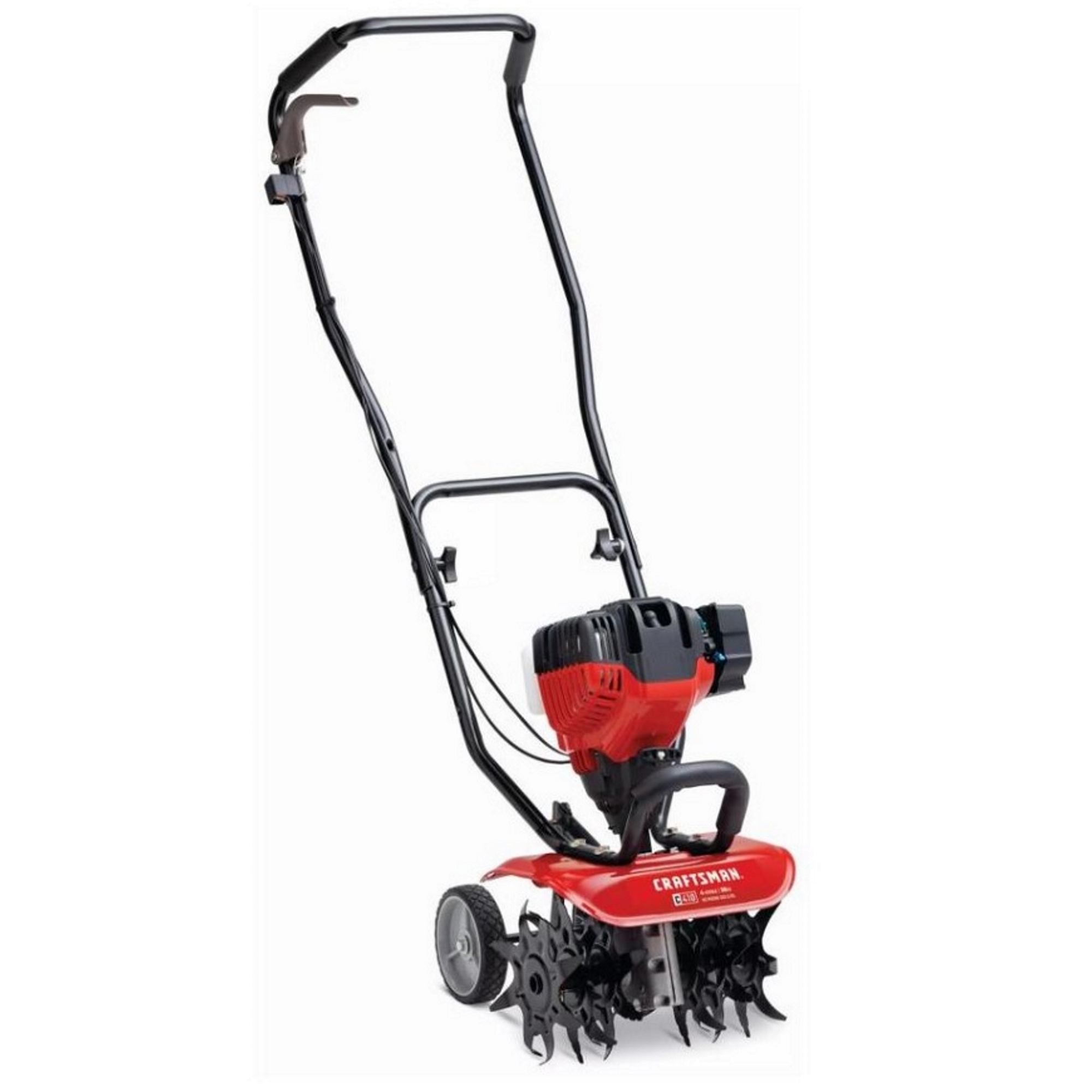
The best tiller overall
The Craftsman 4-cycle Gas Tiller is the best overall, with 6-inch tines, an adjustable tilling path, easy assembly, and a two-year warranty, though it's pricier.
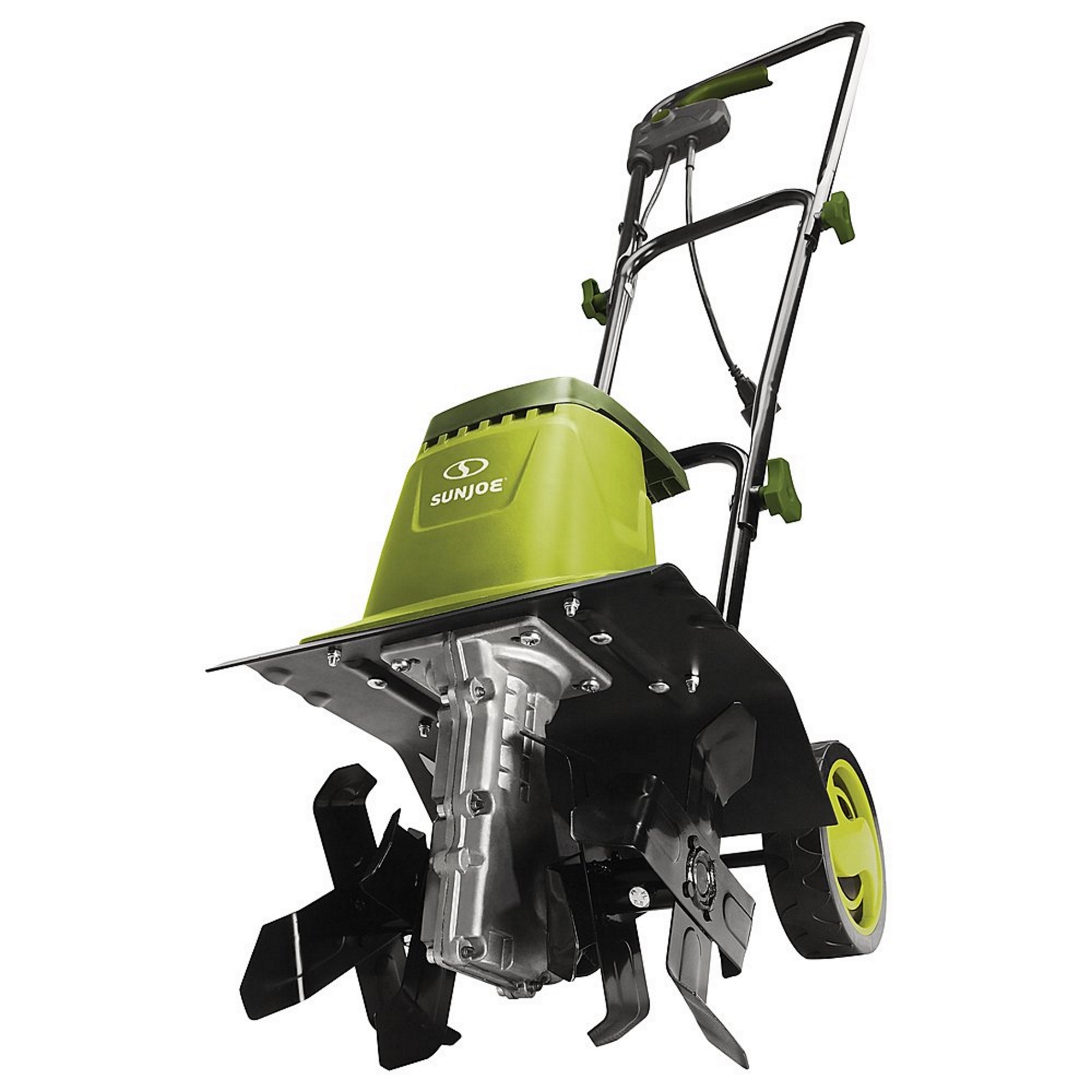
The best electric tiller
The Sun Joe Electric Tiller is easy to assemble, efficient, and good for small-to-medium-sized gardens. It can be 16 inches wide by 8 inches deep.
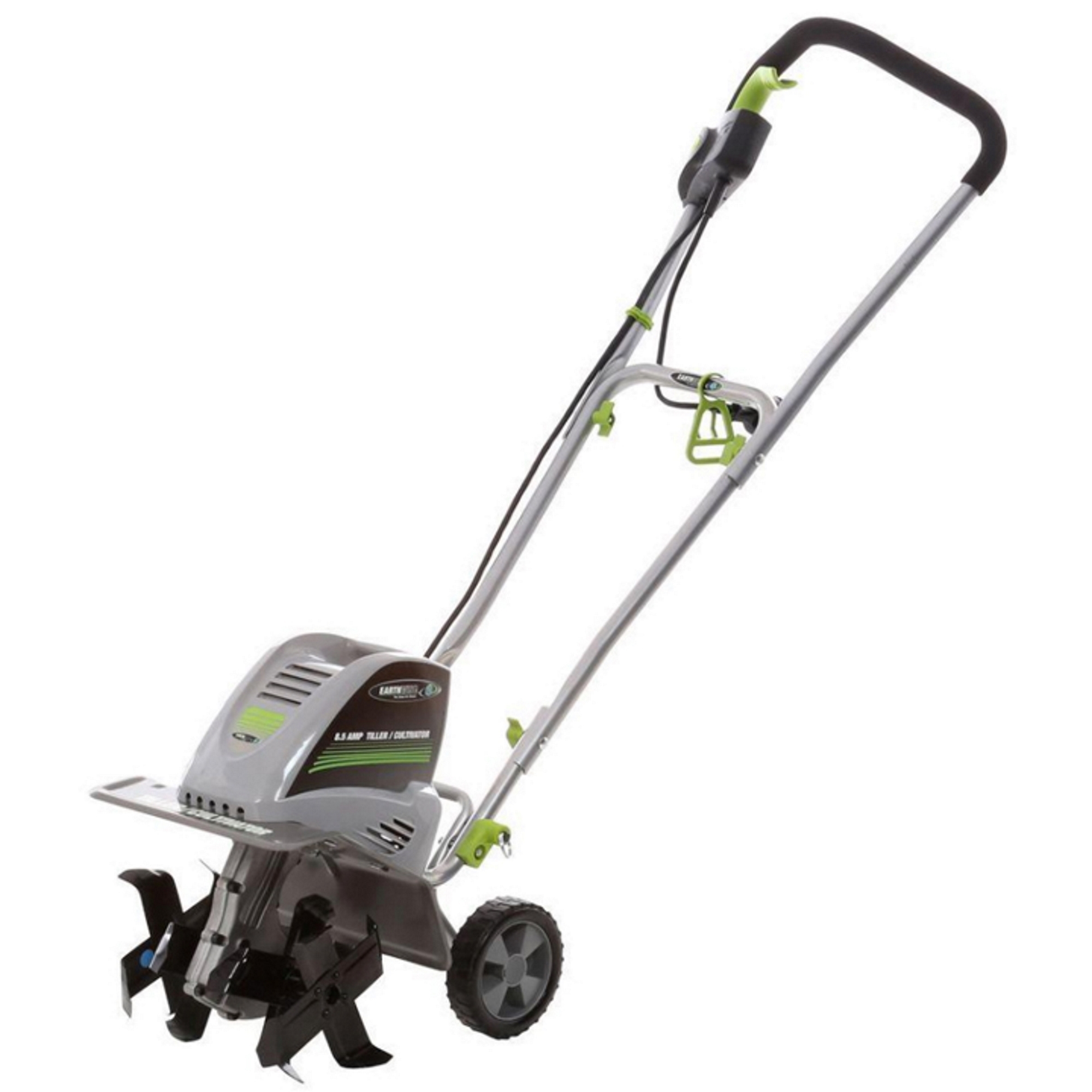
The best tiller on a budget
The Earthwise TC70001 is a budget-friendly option for smaller gardens with moist soil. It is easy to assemble and operate, but it struggles with hardened ground.
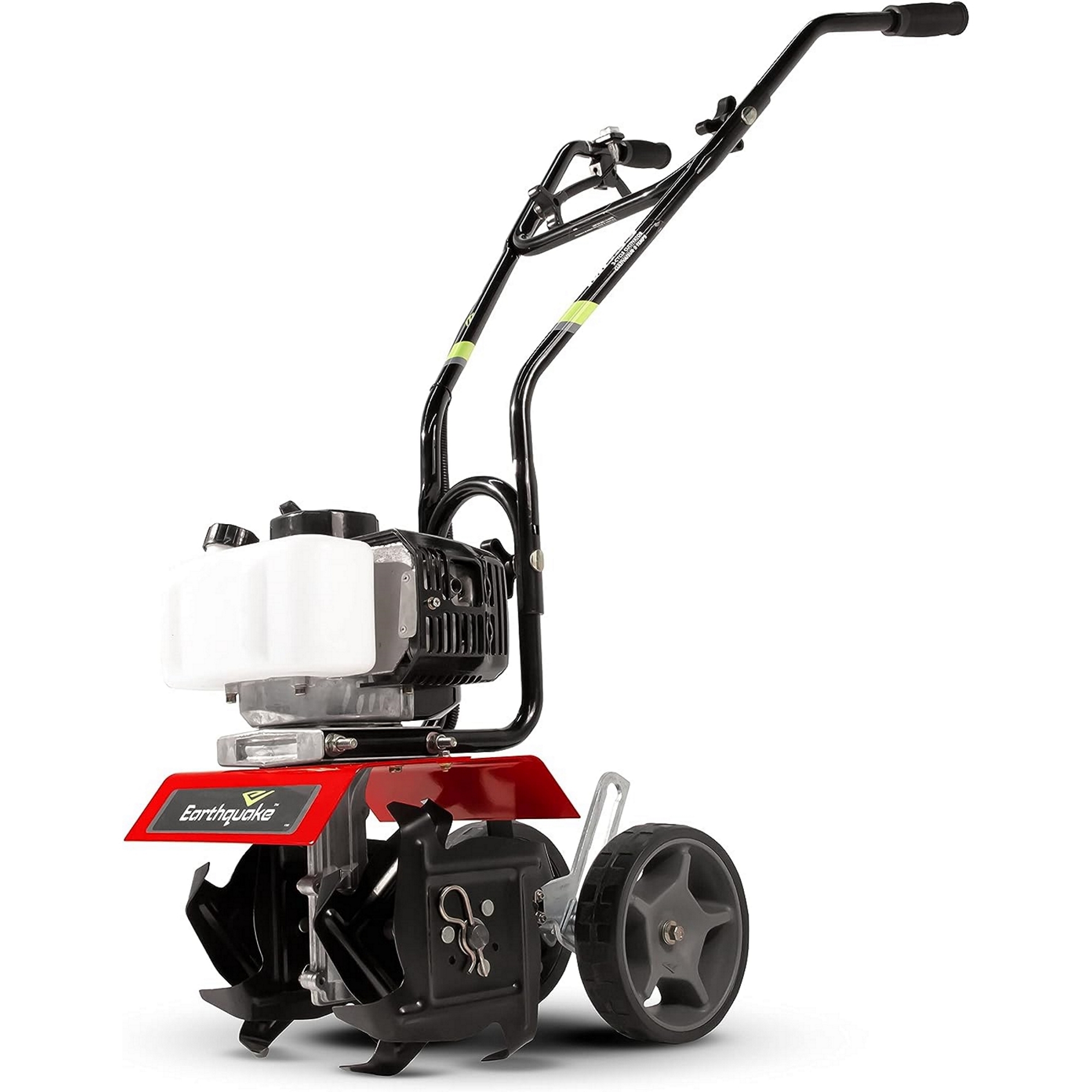
The best tiller for smaller gardens
The Earthquake MC33 Mini Cultivator is a powerful gas-powered tiller for tilling, weeding, aerating, and fertilizing soil. It has a sturdy build and can cut deep trenches.
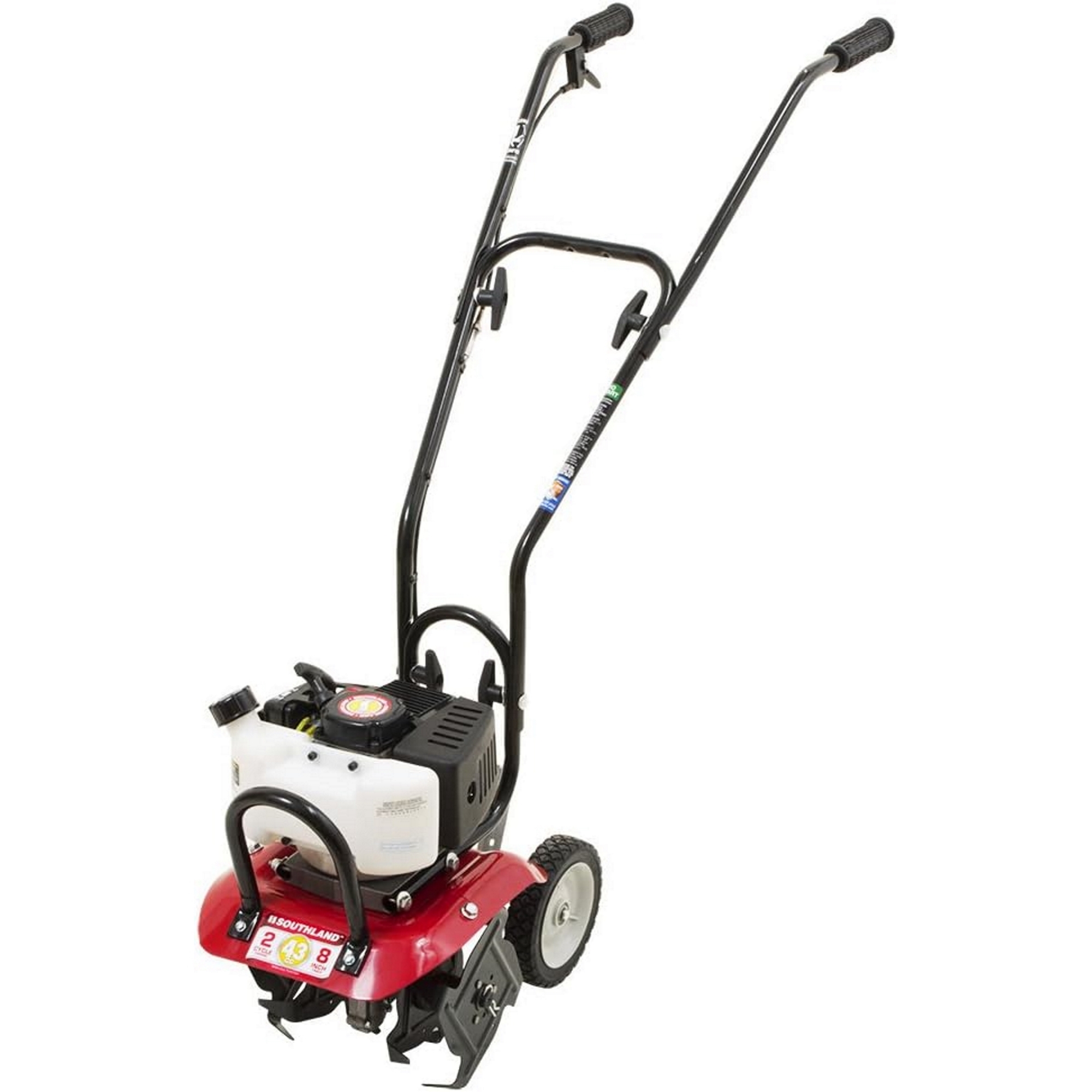
The best gas cultivator
The Southland SCV43 cultivator is a gas-powered tiller with a direct-gear drive and crankshaft engine. It can till up to 5 inches deep and is suitable for small—to medium-sized gardens.
The best tillers we recommend
Why you can trust Top Ten Reviews Our expert reviewers spend hours testing and comparing products and services so you can choose the best for you. Find out more about how we test.
Top Ten Reviews is on a mission to review everything we feature in our buyer's guides. Still, while we work hard to make this a reality—or where this isn't possible—some of our guides still feature rankings based on our team's considerable expertise and research.
While we haven't been able to test any of the units in this guide in person, we've instead honed in on top-rated brands and used our knowledge of the best features to help you make the right decision for your home, all for the best price.
The best tiller overall
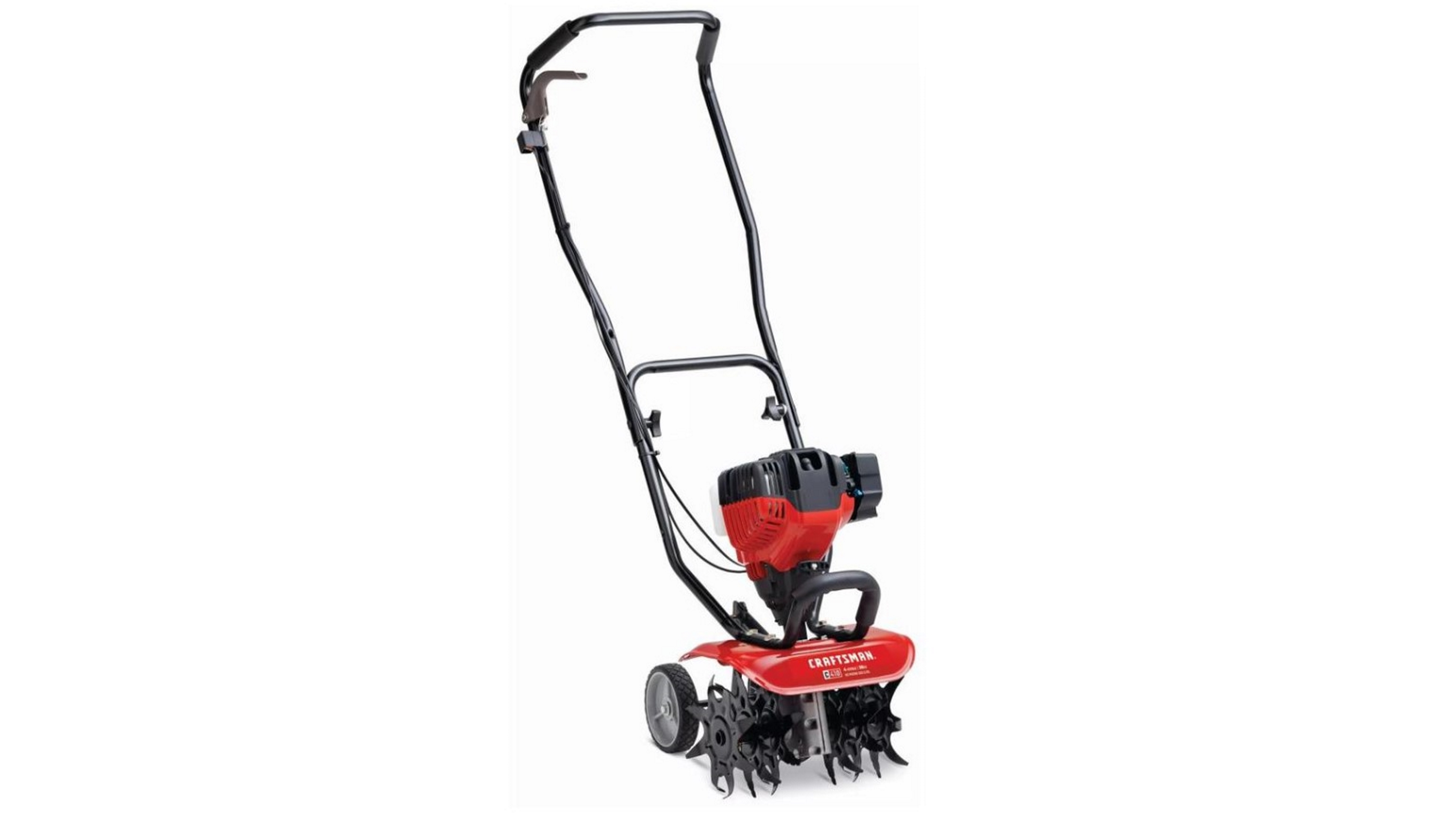
✅ You want something quiet: this tiller has a powerful 4-cycle engine that runs on pure gasoline.
✅ You want versatility: it offers great versatility with a tilling path that can be adjusted from 6 to 12 inches wide.
✅ You want something easy: it comes mostly put together, and assembly is easy and can be done by hand.
❌ You're on a budget: this tiller is expensive, so be aware that others may offer better value for money.
❌ You require depth: With 6-inch tines, other tillers offer greater depth for churning denser soil.
❌ You need something light: at 38lbs, it isn't the lightest tiller on the market.
🔎 Craftsman 29934 Gas Tiller is a powerful, easy-to-use cultivator with an adjustable tilling path and a 4-cycle engine. It's easy to assemble and has a simplified starting. It's a bit expensive but worth the investment if you need a reliable tiller for your garden. It also comes with a two-year warranty. ★★★★
The Craftsman C410 Gas Tiller is our pick for the best tiller overall. A 4-cycle engine and 6-inch tines can churn up denser soil and maintain existing flowerbeds and vegetable patches. You can adjust the tilling path from 6 to 12 inches wide, giving you great control and versatility. It's easy to assemble, use, clean, and store and has a two-year warranty. However, it is more expensive than some other tillers on the market.
First impressions & setup: This tiller is a solid, well-designed machine that is mostly assembled from the box. Putting the tiller together is thus pretty easy and does not require any tools, allowing you to get started quickly. It's also relatively lightweight for a gas-powered tiller, and the variable speed throttle and electric start cable make it easy to use.
Features & performance: With a 4-cycle engine and 6-inch tines, this tiller can churn up denser soil and maintain existing flowerbeds and vegetable patches. You can adjust the tilling path from 6 to 12 inches wide, giving you great control and versatility when tilling your garden or raised beds. It also runs cleaner and quieter than 2-cycle gas tillers but is slightly more expensive.
Maintenance & safety: Maintaining and cleaning this tiller is a breeze, and it comes with a two-year warranty. Keep it well-cleaned and maintained, and it should stay in working order well past the warranty's expiration date.
The best electric tiller
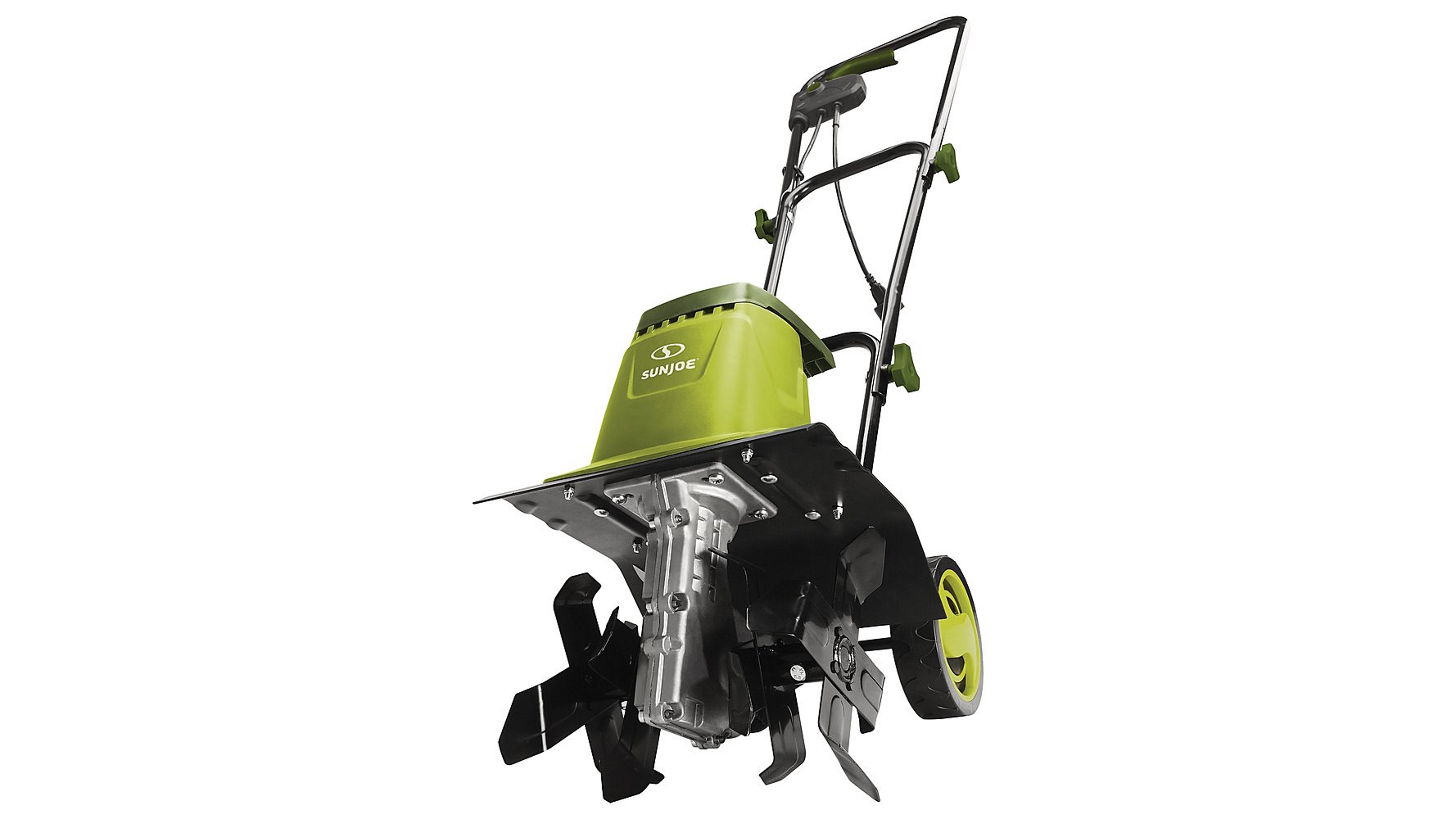
✅ You want easy assembly: this tiller can run within 10 minutes.
✅ You want efficiency: six-angled tines can till up to 16 x 8".
✅ You hate maintenance: the tiller doesn't require fuel and oil mixing and has a 2-year warranty.
❌ You don't want a cord: you will need a long extension cord to use it.
❌ You have deep beds: the tiller is better suited for shadow beds of flowers and vegetables.
❌ You want something powerful: the tiller's 13.5-amp motor may not be enough for tougher soil.
🔎 Sun Joe Electric Tiller is an easy-to-assemble, efficient, and maintenance-free option for small-to-medium-sized gardens. While it's corded and better suited for shallow beds of flowers and vegetables, it cuts up to 8 inches deep and 16 inches wide, eliminating the need for multiple passes. Safety precautions include purchasing a long extension cord and avoiding tangles. ★★★★
The Sun Joe TJ604E Electric Tiller is ideal for preparing soil quickly and efficiently before planting. It's easy to assemble, requires no maintenance, and has a two-year warranty. While it is corded, it's a good choice for those who want the benefits of an electric tiller without having to worry so much about maintenance. The tiller can cut up to 8 inches deep and 16 inches wide, and its six-angled tines ensure you don't have to retill the same patch of soil multiple times.
First impressions & setup: This tiller is an excellent option for those who don't mind a corded machine. It's easy to assemble, with just a few knobs and bolts to attach, and can be up and running within 10 minutes. Once set up, this tiller weighs around 27 lbs and features a 13.5-amp motor and rear wheels, making it easy to maneuver like an electric lawnmower.
Features & Performance: The tiller's six angled tines can till 16 inches wide by 8 inches deep, eliminating the need for multiple passes. It's perfect for small-to-medium-sized gardens, cutting wide and deep into the soil and allowing you to prepare your garden in one pass without going over the same area multiple times. However, this tiller is better suited for shallow beds of flowers and vegetables, while a gas tiller is better for more compacted dirt.
Safety & Maintenance: The tiller is maintenance-free and has a two-year warranty. However, be sure to purchase a long extension cord and watch out for getting it tangled in the tines. You won't have to worry about mixing fuel and oil, as you would with a gas model.
The best tiller on a budget
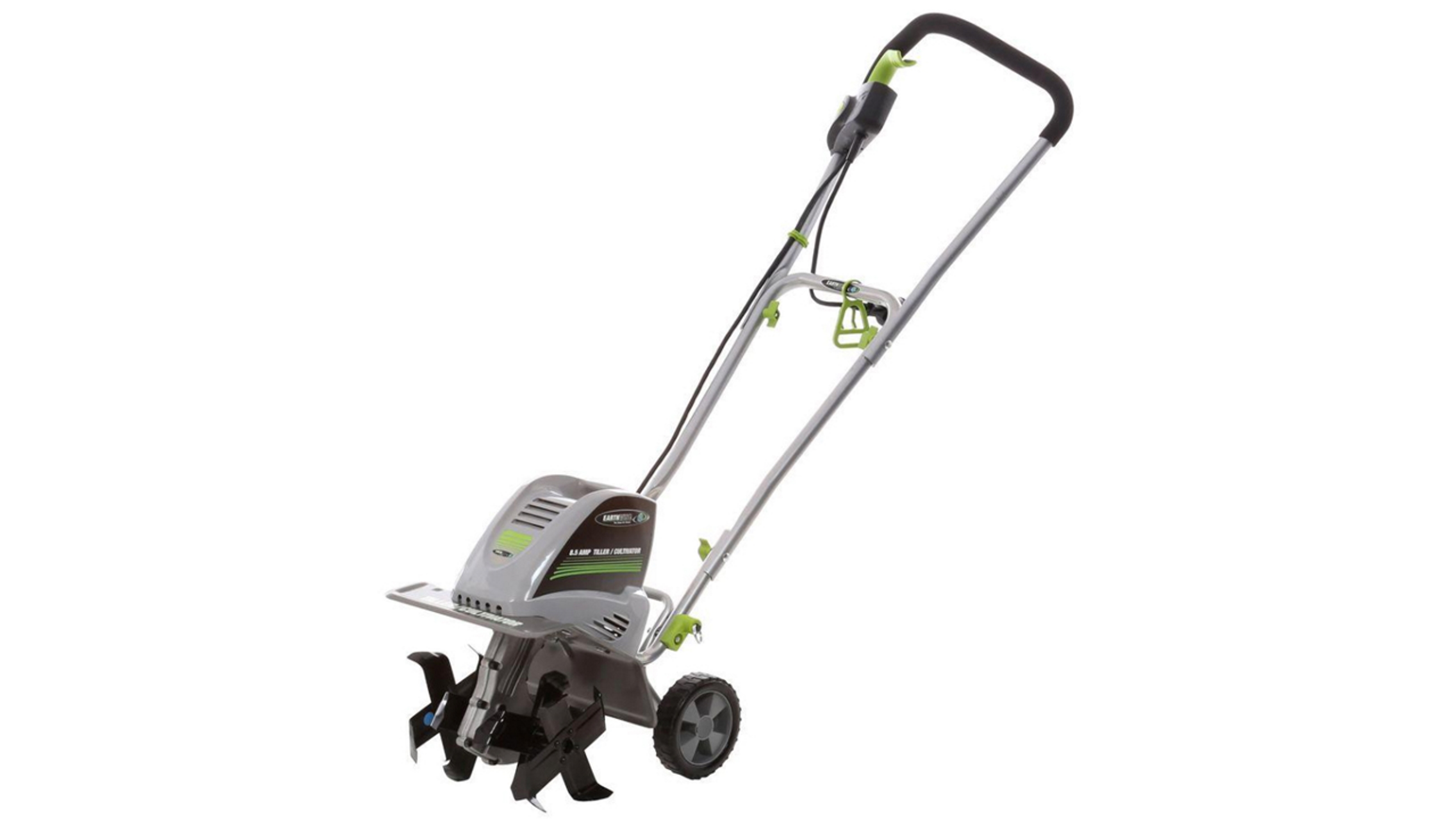
✅ You want easy assembly: this tiller is simple to assemble and operate.
✅ You're on a budget: the product is affordable and has a 2-year warranty.
✅ You have a smaller garden: the tiller would be ideal for smaller spaces with moist soil.
❌ You don't want a cord: the product requires a long extension cord, which is not provided.
❌ You have a large yard: the tiller isn't suitable for extensive gardens.
❌ You want something powerful: the tiller lacks power and struggles with hardened ground.
🔎 Earthwise TC70001 is an affordable, easy-to-assemble electric tiller ideal for smaller gardens with moist soil. While it may struggle with hardened ground, it can till up to 8 inches deep and 11 inches wide. It's easy to push and comes with a two-year limited warranty. Maintenance is straightforward, and a cord retainer helps keep the cord away from the tines for added safety. ★★★★
For those on a budget, the Earthwise TC70001 is an excellent option. Though lacking in power, it's easy to assemble and operate and can till up to 8 inches deep and 11 inches wide on moist soil. It struggles with hardened ground and requires a long extension cord, but it is ideal for personal use and comes with a two-year limited warranty and affordable replacement parts. An excellent choice for beginners seeking a simple and inexpensive tiller, it may not be suitable for more extensive gardens or specific jobs.
First impressions & setup: The electric tiller is small and easy to assemble, weighing only 30 lbs. No special tools are required for setup, and assembly takes only about five minutes, making it one of the quickest tillers to get started with. However, it's worth noting that a long extension cord is required to power the cultivator, which is not included and increases the cost.
Features & Performance: While the tiller lacks power and is unsuitable for breaking up hardened soil, it is ideal for smaller gardens with moist soil. The 8.5-amp motor and rear wheels make it easy to push, and the tines can till up to eight inches deep and 11 inches wide, making it perfect for personal use.
Safety & Maintenance: The cord retainer in the middle of the tiller's shaft helps keep the cord away from the rotating tines, reducing the risk of accidents. The tiller also has a two-year limited warranty.
The best tiller for smaller gardens
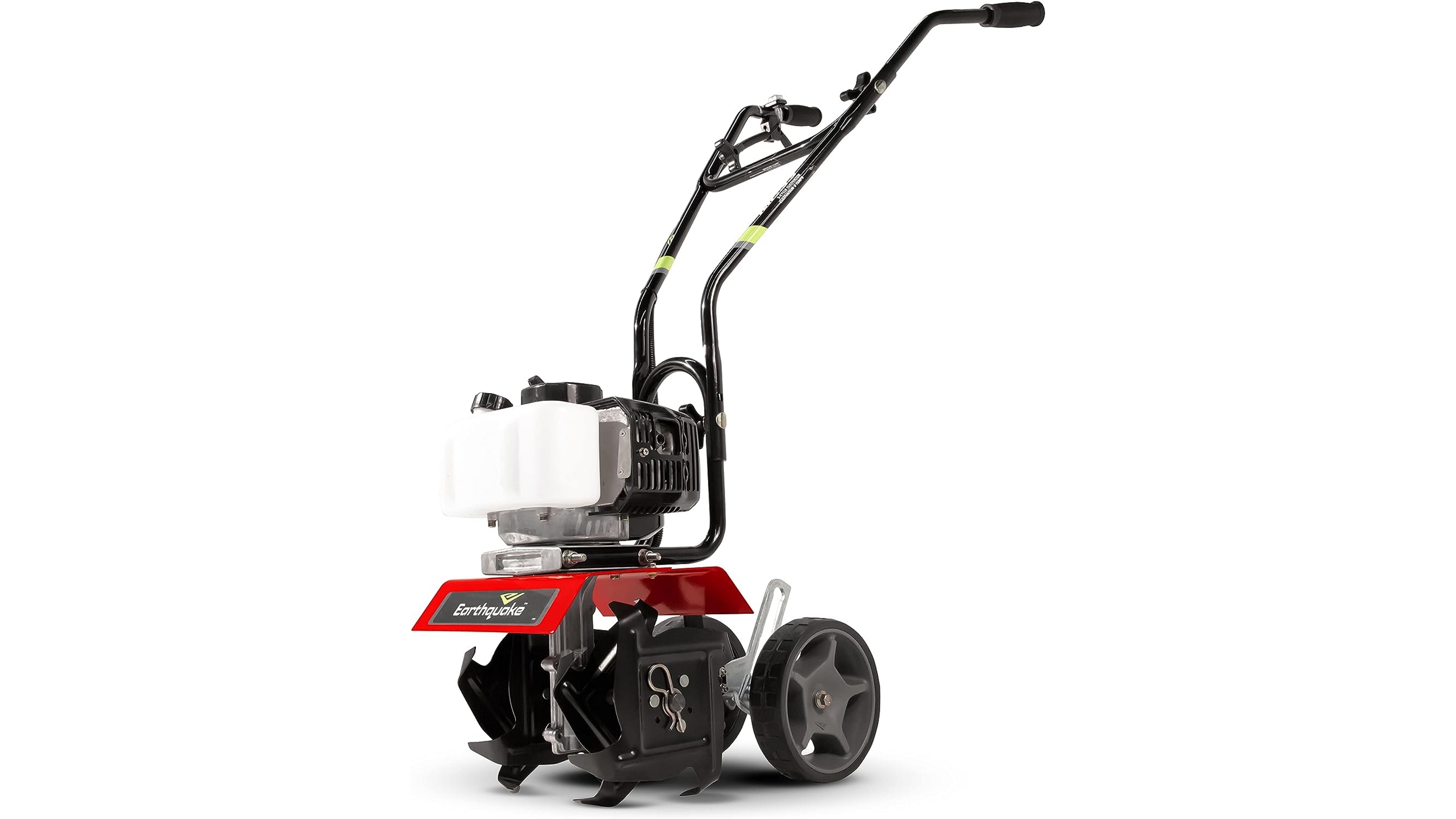
✅ You want power: this tiller has a two-cycle Viper engine.
✅ You want something gas-powered: you won't need to worry about being tethered to extension cords.
✅ You need something sturdy: the tiller has a sturdy build for heavy users.
❌ You hate noise: this tiller is noisier than electric models.
❌ You don't want a recoil system: starting the engine requires pulling a cord.
❌ You need something light: the tiller is one of the heavier ones on the market.
🔎 Earthquake MC33 Mini Cultivator has a sturdy build and a powerful two-cycle Viper engine, perfect for tilling, weeding, aerating, and fertilizing soil. It's gas-powered, so no extension cord is needed, but it's noisier than electric models. Assembly is easy, but the recoil starting system can be challenging. Ideal for smaller gardens. ★★★★
The Earthquake MC33 Mini Cultivator has a sturdy build and a powerful two-cycle Viper engine, meaning it can easily cut trenches up to six inches deep and ten inches wide. This makes it ideal for tilling, weeding, aerating, and fertilizing soil. It's gas-powered, so you don't need an extension cord, but note that it is noisier than electric models. While it is one of the heavier tillers on the market, its powerful engine makes it easy to push through the soil.
First impressions & setup: Although this tiller is an older model, it has a sturdy build and a powerful two-cycle Viper engine, which makes it easy to push through the soil. It is relatively easy to assemble, with clear instructions in the user manual. At 33 pounds, it's also one of the heavier tillers on the market, but this weight is offset by its powerful engine.
Features & Performance: This tiller is a valuable tool for those with smaller gardens. It can cut trenches up to six inches deep and ten inches wide, allowing you to till your soil, weed your garden, aerate the soil, and add fertilizer. It is gas-powered, so you don't need an extension cord to use it, but it is also noisier than electric models. Note that the recoil starting system requires you to pull a cord to start it, which can be challenging.
The best gas cultivator
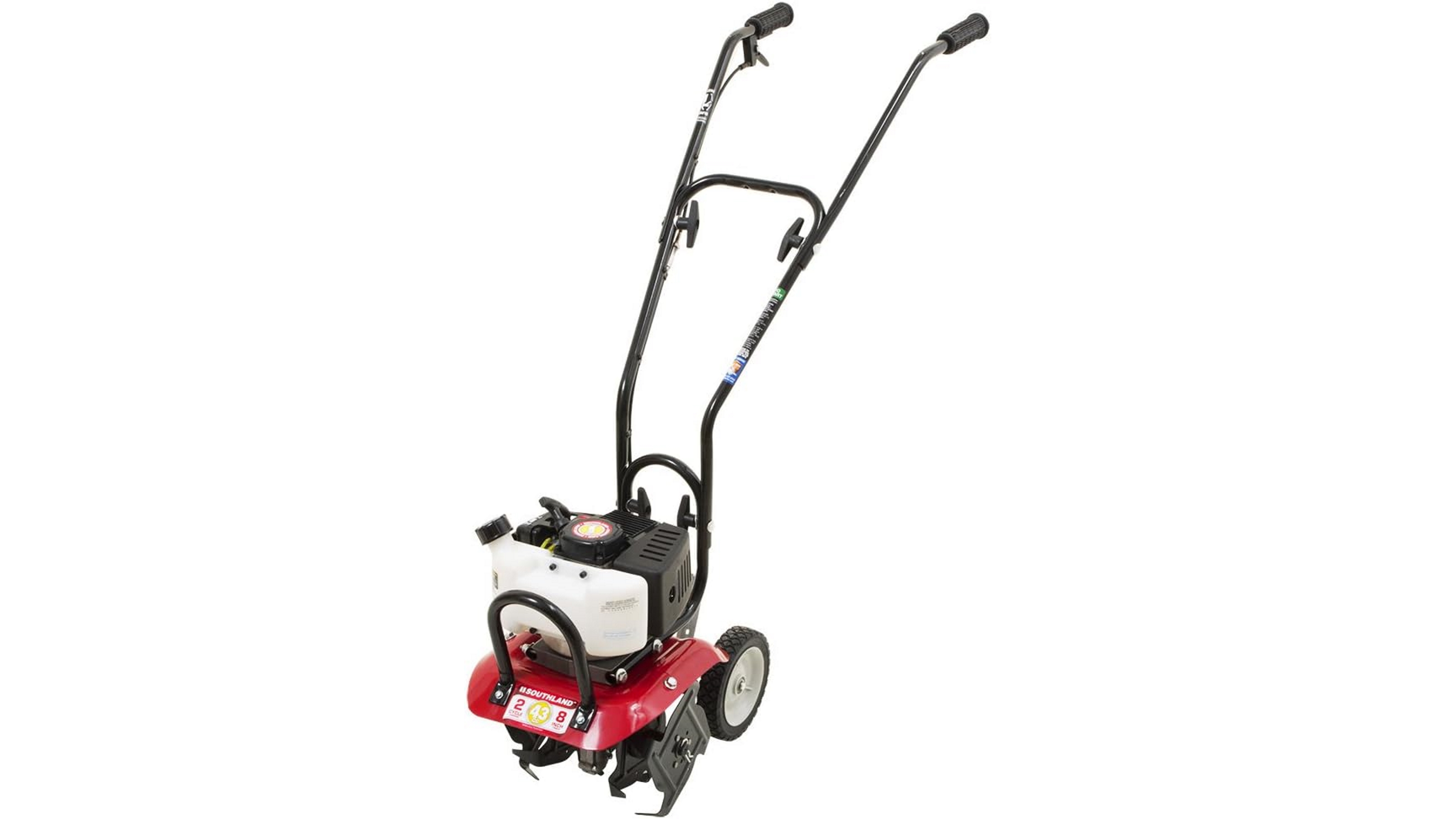
✅ You want power: this tiller has a direct-gear drive and crankshaft engine.
✅ You want easy maneuverability: the cultivator is equipped with rear wheels.
✅ You need easy storage: the front carry handle makes for easier transport and storage.
❌ You don't want to assemble: you must set aside some time for assembly.
❌ You have deep soil: it may not go deep enough for larger gardens.
❌ You don't want a gas tiller: the model requires you to mix gas and oil.
🔎 Southland SCV43 cultivator is a gas-powered tiller with a powerful engine and maneuverable rear wheels. Assembly takes around 30 minutes and can till up to 5 inches deep. It is heavier than most tillers but can still be easily transported and stored. ★★★★
The Southland SCV43 cultivator is a gas-powered tiller that easily handles tilling ground with its powerful direct-gear drive and crankshaft engine. Though it may not go as deep as some other tillers, it still offers a lot of value for creating and maintaining small—to medium-sized gardens.
Its gas engine provides plenty of power to get the job done, and the cultivator has rear wheels, which make it more maneuverable than some other models. Despite being heavier than many other tillers, the Southland SCV43 can still be easily transported and stored.
First impressions & setup: We will note that the Southland SCV43 requires some assembly out of the box, as while most of the unit comes pre-assembled, you'll still need to attach the handlebars and shaft to the drive module and cut the tines to the tine shaft. Thankfully, this isn't too complicated and can be done by hand with the instructions provided. All in all, expect to spend around 30 minutes on assembly.
Features & Performance: This cultivator is a gas-powered tiller that weighs 41 pounds, making it one of the heavier options on the market. However, its direct-gear crankshaft engine is very powerful and makes it easy to use. To start the machine, you only need to pull the starting cord, and the tines will start turning immediately.
This cultivator has 7-inch rear wheels, which provide extra maneuverability, so you can easily push it through your garden. This garden tiller can turn dirt up to 5 inches deep, which is enough to help water reach the roots of your plants and make adding fertilizer easier. However, you may consider a tiller up to 8 inches deep if you have a larger garden.
Safety & Maintenance: Because this tiller has a two-cycle gas engine, you must mix gas and oil to fuel it. While this is less clean and convenient than four-cycle options, it does make two-cycle tillers more affordable. The front carrying handle makes it easier to transport, and the folding handle can be collapsed for easy storage, so you won't have to worry about it taking up too much space when you're not using it.
How to choose the best tiller for you
So, how do you choose the right tiller for you? Consider what you want to achieve and opt for the tiller to handle the task. Some tillers are designed to help you remove pesky weeds and aerate the soil, while others are better for working in compost and fertilizers. If you’re working on a new plot that has never been tilled, look for a powerful machine with robust tines. This may not be necessary if your soil has been turned before and you want to refresh it before summer planting. Whatever your needs, there’s a tiller out there for you.
The tiller has stood the test of time and has been used in agriculture for centuries. They’re a proven way of breaking up compact earth and transforming it into loose, aerated soil, making planting a breeze. They can add extra goodness to the soil, like organic compost, and even remove weeds. Bear in mind, though, that tilling the soil does have its downsides, as it can result in soil erosion and increase the need for pesticides. You’ll have to consider whether the benefits outweigh the disadvantages.
Tillers are best suited for preparing large areas of land. They’re also a good choice when preparing a plot for the first time, particularly if it’s been unloved and the soil is compacted and lacking nutrients.
You can find smaller models, often called cultivators. These are ideal for more delicate jobs like weeding between seedlings or adding compost to an empty bed. However, they may struggle to cope with breaking up stubborn roots and dense soil, so in this scenario, you’d be better off with a more powerful tiller.
We’ve included a range of different tillers and cultivators in our round-up to determine what suits your needs. We’ve scouted models in all shapes and sizes, including ones designed for different tasks. You’ll find models you can assemble and ones that come fully assembled easily.
Tiller FAQs
How do tillers work?
Tillers are ideal if you have a sizeable garden that needs work, as these handy devices are used for breaking up soil. They help to increase the fertility of the soil as it is aerated and turned over, which helps oxygen, nutrients, and water to reach the roots more efficiently. There are different types of tillers, front-tine and rear-tine, but they both work similarly. As the name suggests, the main difference is where the tine – or blades – are situated. Front-tine tillers often have wheels at the back to help movement, while rear-tine tillers are often bigger and heavier, with the tines at the back. Tillers work by the tines rotating and digging into the soil after a drag bar has been set to the correct depth. It can break up the surface-level soil or dig further down to help with weed removal.
How much do tillers cost?
It depends on the size of the tiller and your needs. A small front-tine tiller suitable for light garden work can start from $50 to $500+ for a top-of-the-range model that can tackle large areas. Rotary/manual tillers are also available for $20, but electric or gas-powered models are a little more expensive for the convenience and extra work involved.
Can tillers cut through roots?
It depends on how powerful the model you choose is and the type of roots. Tillers can make light work of deeply rooted weeds; however, things like tree roots risk breaking tillers, so it is best to avoid them in case of accident and injury.
